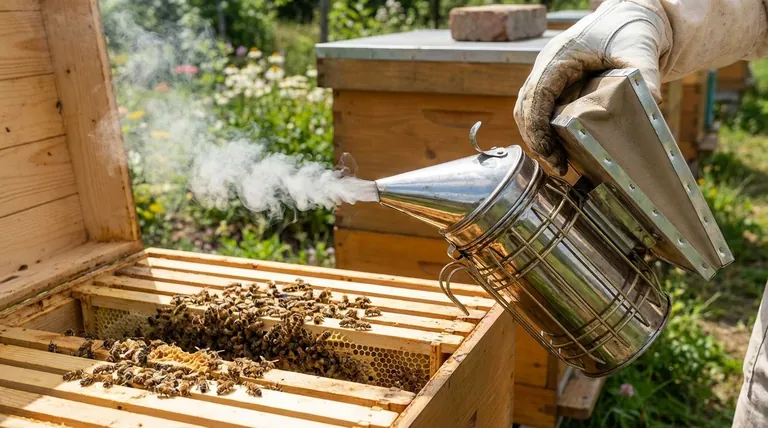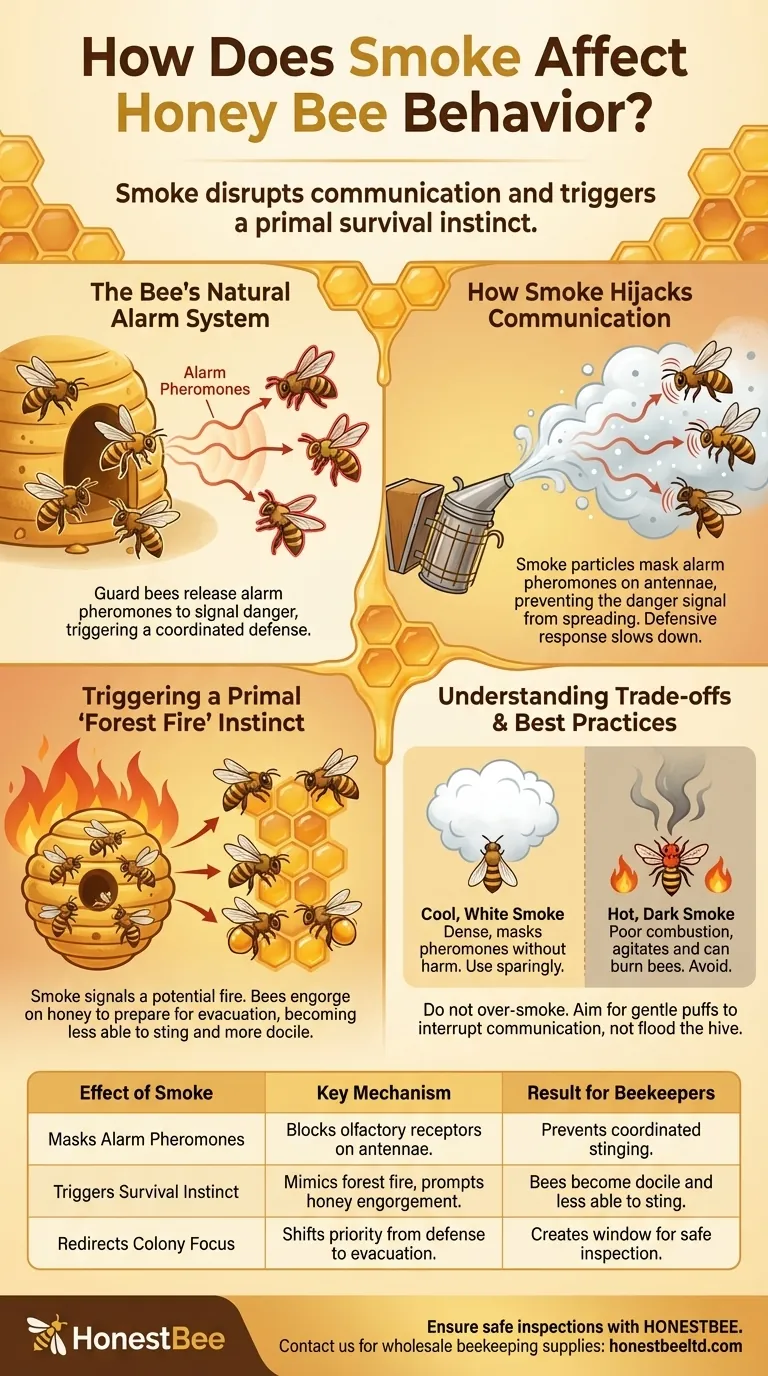At its core, smoke affects honey bees by disrupting their primary method of communication and triggering a primal survival instinct. The smoke molecules mask the alarm pheromones that guard bees release to signal danger, preventing a coordinated defensive response from the colony. This interruption, combined with an instinct to prepare for a potential hive-destroying fire, results in what beekeepers perceive as a "calm" hive.
The use of smoke is not a sedative. Instead, it effectively hijacks the bees' sensory and communication systems, redirecting their collective focus from defending the hive to preparing for a potential evacuation.

The Bee's Natural Alarm System
To understand why smoke works, you must first understand how a colony defends itself. The process relies on rapid, scent-based communication.
Guard Bees and Alarm Pheromones
Specialized guard bees monitor the hive entrance for threats. When a threat is detected, they release chemical signals known as alarm pheromones.
These pheromones instantly alert other bees in the colony to the danger, triggering an immediate and coordinated defensive response, which often involves stinging.
How Smoke Hijacks Bee Communication
A smoker is a beekeeper's tool for preventing this defensive cascade. Its effect is direct and biochemical.
Masking the Scent of Danger
The particles in smoke overwhelm the bees' olfactory receptors, which are located on their antennae.
This effectively masks the alarm pheromones, preventing the signal from spreading throughout the colony. If the other bees cannot smell the alarm, they do not know there is a danger to react to.
Slowing the Defensive Response
Without the ability to communicate the threat, the bees cannot mount an effective, large-scale defense. Their response becomes slower and less coordinated.
This gives the beekeeper a critical window to open and inspect the hive without triggering the colony's full defensive force.
Triggering a Primal Survival Instinct
Beyond simply blocking communication, smoke triggers a deeper, instinctual behavior rooted in the bees' ancient response to forest fires.
The "Forest Fire" Response
The presence of smoke signals a potential fire, which would mean the destruction of the bees' home and honey stores. Their priority instantly shifts from defense to survival.
Instead of preparing to fight, the bees prepare to abscond, or abandon the hive. To do this, they need energy for the long flight to find a new home.
Engorging on Honey
In preparation for this potential evacuation, the bees will immediately go to the honey cells and begin engorging themselves.
A bee with a full stomach of honey is physically less able to flex its abdomen to sting. This physiological change, combined with their shifted mental focus, makes them significantly more docile.
Understanding the Trade-offs and Best Practices
Using smoke is a technique that requires skill. The wrong application can be counterproductive or even harmful to the bees.
Cool, White Smoke vs. Hot, Dark Smoke
The goal is to produce cool, white smoke. This type of smoke is dense enough to mask pheromones without harming or overly agitating the bees.
Hot, dark smoke is a sign of poor combustion and can burn the bees' wings or cause them to become more agitated and aggressive. It signals a more immediate danger, defeating the purpose.
The Risk of Over-smoking
Using too much smoke can be just as bad as using the wrong kind. It can overly stress the colony, disrupt hive activity for an extended period, and even taint the flavor of the honey.
The principle is to use just enough smoke to keep communication interrupted, not to flood the hive unnecessarily. A few gentle puffs at the entrance and under the cover is often all that is needed.
How to Apply This to Your Hive
Your approach to using smoke should be deliberate and adapted to the colony's temperament and your specific goal.
- If your primary focus is a routine inspection: Use a few gentle puffs of cool, white smoke at the hive entrance and wait 30-60 seconds before opening the hive to allow the effects to take hold.
- If you notice the bees are becoming agitated: Do not respond with large amounts of smoke. Instead, check that your smoke is cool and white, apply a small puff, and give the bees a moment to reset.
- If your goal is to minimize stress on the colony: Use smoke preventatively and sparingly. The goal is to keep alarm levels from ever escalating, rather than trying to quell a defensive response that has already begun.
Mastering the use of smoke is about understanding that you are gently manipulating the bees' natural instincts, not overpowering them.
Summary Table:
| Effect of Smoke | Key Mechanism | Result for Beekeepers |
|---|---|---|
| Masks Alarm Pheromones | Smoke particles block olfactory receptors on bee antennae. | Prevents coordinated defensive stinging response. |
| Triggers Survival Instinct | Mimics a forest fire, prompting bees to engorge on honey. | Bees become docile and less able to sting. |
| Redirects Colony Focus | Shifts priority from defense to potential evacuation. | Creates a critical window for safe hive inspection. |
Ensure your hive inspections are safe and efficient with the right equipment from HONESTBEE. We supply commercial apiaries and beekeeping equipment distributors with high-quality, wholesale-focused supplies—including reliable smokers designed for optimal cool, white smoke. Let our expertise help you manage your colonies with confidence. Contact HONESTBEE today to discuss your wholesale needs and enhance your beekeeping operations.
Visual Guide

Related Products
- Stainless Steel Honey Bee Smoker Hive and Honeycomb Smoker for Beekeeping
- European Stainless Steel Bee Smoker for Honey Bee Hive
- Stainless Steel Electric Beehive Smoker for Beekeeping and Bee Keeper Use
- Premium Traditional Copper Bee Smoker with Bellows
- Electric Bee Smoker European Style Bee Hive Smoker for Beekeeping
People Also Ask
- What is a Smoker and how is it used in beekeeping? The Essential Tool for Calm, Safe Hive Inspections
- What is a bee smoker and how does it work? Master the Tool for Calm, Safe Hive Inspections
- What happens to bees when they sense smoke? Unlock the Secret to Calm Hive Inspections
- What is the smoke that beekeepers use? The Secret to Safe and Calm Hive Inspections
- What is the primary purpose of using smoke in beekeeping? Calm Bees for Safer Hive Management



















